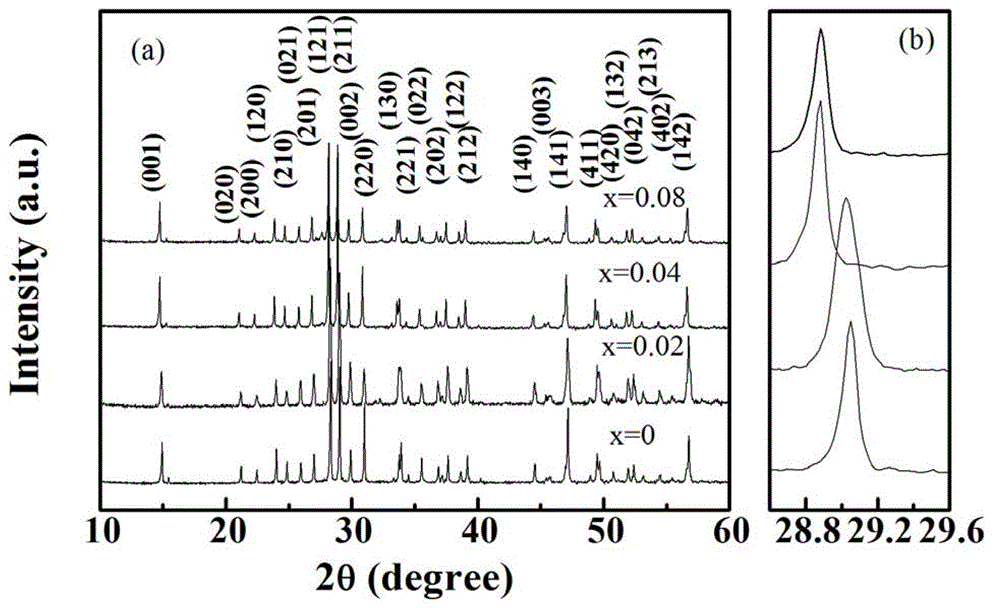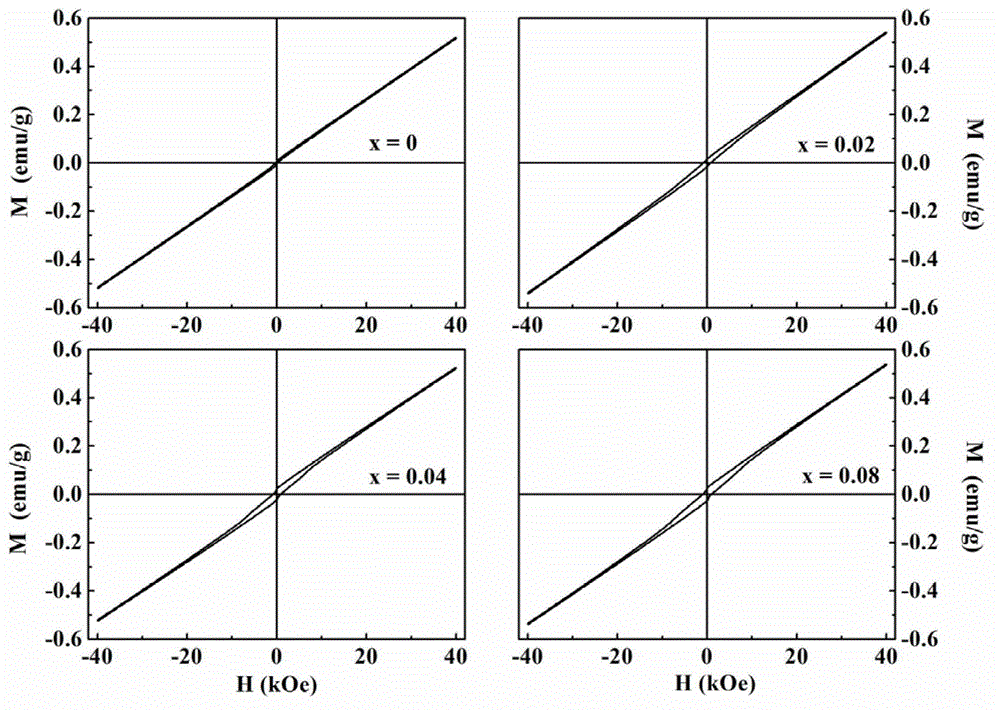Cr-doped Bi2Fe4O9 multiferroic ceramic material and preparation method thereof
A technology of multiferroic ceramics and bi2fe4o9, which is applied in the field of transition metal doped Bi2Fe4O9 multiferroic ceramic materials and its preparation, can solve the problems that there are no reports on multiferroic ceramic materials, and achieve low cost, low leakage current, and preparation The effect of simple process
- Summary
- Abstract
- Description
- Claims
- Application Information
AI Technical Summary
Problems solved by technology
Method used
Image
Examples
Embodiment 1
[0022] Bi 2 Fe 4(4-x) Cr 4x o 9 (x=0) Multiferroic ceramics. In the first step, weigh 0.02mol of bismuth nitrate and put it into a 100mL beaker, add 30mL of deionized water, and dissolve it under ultrasonic dispersion to form a transparent solution; then weigh 0.04mol of ferric nitrate and add it to the above solution under constant stirring, After being dissolved, weigh 0.06mol of citric acid and add it to the above solution and dissolve; under ultrasonic dispersion, add 8ml of ethylene glycol to form a transparent solution; wherein, the molar ratio of citric acid to the sum of the above two metals is 1 :1. In the second step, under constant stirring, the pH value was adjusted to 7 with ammonia water, and the mixed solution was aged in a water bath for 11 hours. Then, evaporate the solution to dryness in a water bath at 100°C to obtain the corresponding gel, and dry it in an oven at 170°C until a xerogel is formed; glue, causing it to undergo self-propagating combustion...
Embodiment 2
[0025] Bi 2 Fe 4(4-x) Cr 4x o 9 (x=0.02) Multiferroic ceramics. In the first step, weigh 0.02mol of bismuth nitrate and put it into a 100mL beaker, add 30mL of deionized water, and dissolve it under ultrasonic dispersion to form a transparent solution; then weigh 0.0392mol of ferric nitrate and 0.0008mol of chromium nitrate respectively under constant stirring Add it into the above solution, and after it dissolves, weigh 0.06mol citric acid and add it to the above solution and dissolve; under ultrasonic dispersion, add 8ml of ethylene glycol to form a transparent solution; wherein, the molar ratio of citric acid is the same as that of the above three metals and the molar ratio is 1:1. In the second step, under constant stirring, the pH value was adjusted to 7 with ammonia water, and the mixed solution was aged in a water bath for 11 hours. Then, evaporate the solution to dryness in a water bath at 100°C to obtain the corresponding gel, and dry it in an oven at 170°C until...
Embodiment 3
[0028] Bi 2 Fe 4(4-x) Cr 4x o 9 (x=0.04) Multiferroic ceramics. In the first step, weigh 0.02mol of bismuth nitrate and put it into a 100mL beaker, add 30mL of deionized water, and dissolve it under ultrasonic dispersion to form a transparent solution; then weigh 0.0384mol of ferric nitrate and 0.0016mol of chromium nitrate respectively under constant stirring Add it into the above solution, and after dissolving, weigh 0.06mol citric acid and add it to the above solution and dissolve; under ultrasonic dispersion, add 8ml of ethylene glycol to form a transparent solution; wherein, the molar ratio of citric acid is the same as that of the above three metals and the molar ratio is 1:1. In the second step, under constant stirring, the pH value was adjusted to 7 with ammonia water, and the mixed solution was aged in a water bath for 11 hours. Then, evaporate the solution to dryness in a water bath at 100°C to obtain the corresponding gel, and dry it in an oven at 170°C until a...
PUM
 Login to View More
Login to View More Abstract
Description
Claims
Application Information
 Login to View More
Login to View More - R&D
- Intellectual Property
- Life Sciences
- Materials
- Tech Scout
- Unparalleled Data Quality
- Higher Quality Content
- 60% Fewer Hallucinations
Browse by: Latest US Patents, China's latest patents, Technical Efficacy Thesaurus, Application Domain, Technology Topic, Popular Technical Reports.
© 2025 PatSnap. All rights reserved.Legal|Privacy policy|Modern Slavery Act Transparency Statement|Sitemap|About US| Contact US: help@patsnap.com



